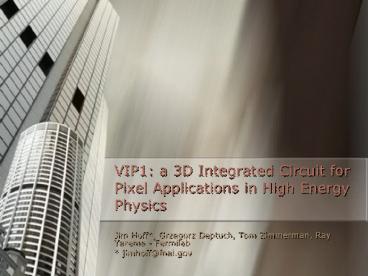VIP1: a 3D Integrated Circuit for Pixel Applications in High Energy Physics PowerPoint PPT Presentation
Title: VIP1: a 3D Integrated Circuit for Pixel Applications in High Energy Physics
1
VIP1 a 3D Integrated Circuit for Pixel
Applications in High Energy Physics
- Jim Hoff, Grzegorz Deptuch, Tom Zimmerman, Ray
Yarema - Fermilab - jimhoff_at_fnal.gov
2
Vertical Integration (a.k.a. 3D Integration)
What is it?
- Several active semiconductor layers
independently designed - Not necessarily the same function
- Not necessarily the same technology
- Thinned
- Bonded together
- Interconnected to one another with deep vias
3
Vertical Integration (a.k.a. 3D Integration)
What is it?
4
Vertical Integration (a.k.a. 3D Integration)
What is it?
J. Joly, LETI
- Industrys Interest in Vertical Integration
- Moores Law
- Reduce R, L, C for higher speed
- Reduce chip I/O pads
- Provide increased functionality
- Reduce interconnect power and crosstalk
- HEPs Interest in Vertical Integration
- Reduced Mass in the Beamline
- Selectable detector and readout technologies
- Increased functionality per unit area at a given
feature size
5
VIP1 What is it?
The VIP1 is a 64x64 demonstrator version of a 1k
x 1k readout chip for ILC pixel vertex
applications. It is designed to conform to ILC
standards as they are understood today.
- Features
- 20 mm x 20 mm pixel size
- Binary (hit/no hit) information with analog hit
information to improve resolution - Double Correlated Sampling
- Both analog and digital time stamping, each
individually capable of resolving 32 time steps
per bunch train. - Readout between bunch trains
- Data sparsification with pipelined token passing
- A single point-to-point serial output line
- Design for megapixel array, but layout a 64x64
array - Low power (assuming power pulsing is used)
- A Test input per pixel
6
VIP1 Overall System Architecture
7
VIP1 Pixel Cell Block Diagram
8
Conversion to a 3D architecture
- Inter-tier vias are substantial
- Logical versus physical division of function
- Layout on one tier impacts layout on other tiers.
9
The Pixel Cell on Tier 1
- SR-ff for hit storage for the duration of the
pulse train. - OR to allow universal read
- Conservative, static, edge-triggered DFF in data
sparsification. - Dynamic edge-triggered DFF for test input pulses
- 65 transistors
10
The Pixel Cell on Tier 2
- 5 bit digital timestamp latched in the pixel
from a Gray Code counter on the periphery of Tier
2 - Analog time stamp resolution to be determined,
but expecting 5 bits - Time stamps can be used in alone or in series to
create a 10 bit time stamp. - 72 transistors
11
The Pixel Cell on Tier 3
- Integrator
- Double correlated sample plus readout
- Discriminator
- Chip scale programmable threshold input
- Capacitive test input (CTI)
- 38 transistors
- 2 vias
12
3D Stacking (of a single pixel) with Vias (step
1)
Tier 1 pixel circuit
Buried oxide (BOX), 400 nm thick
2000 ohm-cm p-type substrate
13
3D Stacking (of a single pixel) with Vias (step
2)
Bond tier 2 to tier 1
Tier 2
Tier 1
14
3D Stacking (of a single pixel) with Vias (step
3)
Form 3 vias, 1.5 x 7.3 µm, through Tier 2 to Tier
1
15
3D Stacking (of a single pixel) with Vias (step
4)
Bond tier 3 to tier 2
Tier 3
Tier 2
16
3D Stacking (of a single pixel) with Vias (step
5)
Form 2 vias, 1.5 x 7.3 µm, through tier 3 to tier
2
17
A 64x64 Array with Perimeter Logic
- Perimeter circuitry for the ILC Demonstrator chip
occupies a small amount of space. - Area for the perimeter logic could be reduced in
future designs.
Blow up of corner of array
64 x 64 array with perimeter logic
18
Status
- The design was submitted in October of last year.
It was due in August of this year. - We expect delivery any day and hope to present
experimental results in the conference record or
in a TNS paper. - This design was fabricated as part of a
multi-project wafer run supported as a DARPA RD
effort. This was the second such run. - A third MPW run is planned for next year.
19
Background Slides
20
Output
- Assume 1000 x 1000 array (1000 pixels/row)
- Token skip frequency 0.2ns
- Time to scan 1 row .200 ns x 1000 200 ns
(simulated) - Time to readout cell 30 bits x 20 ns/bit 600
ns - Max hits/chip 250 hits/mm2 x 225 mm2 56250
hits/chip. - For 50 MHz readout clock and 30 bits/hit, readout
time 57250 hits x 30 bits/hit x 20 ns/bit 34
msec

